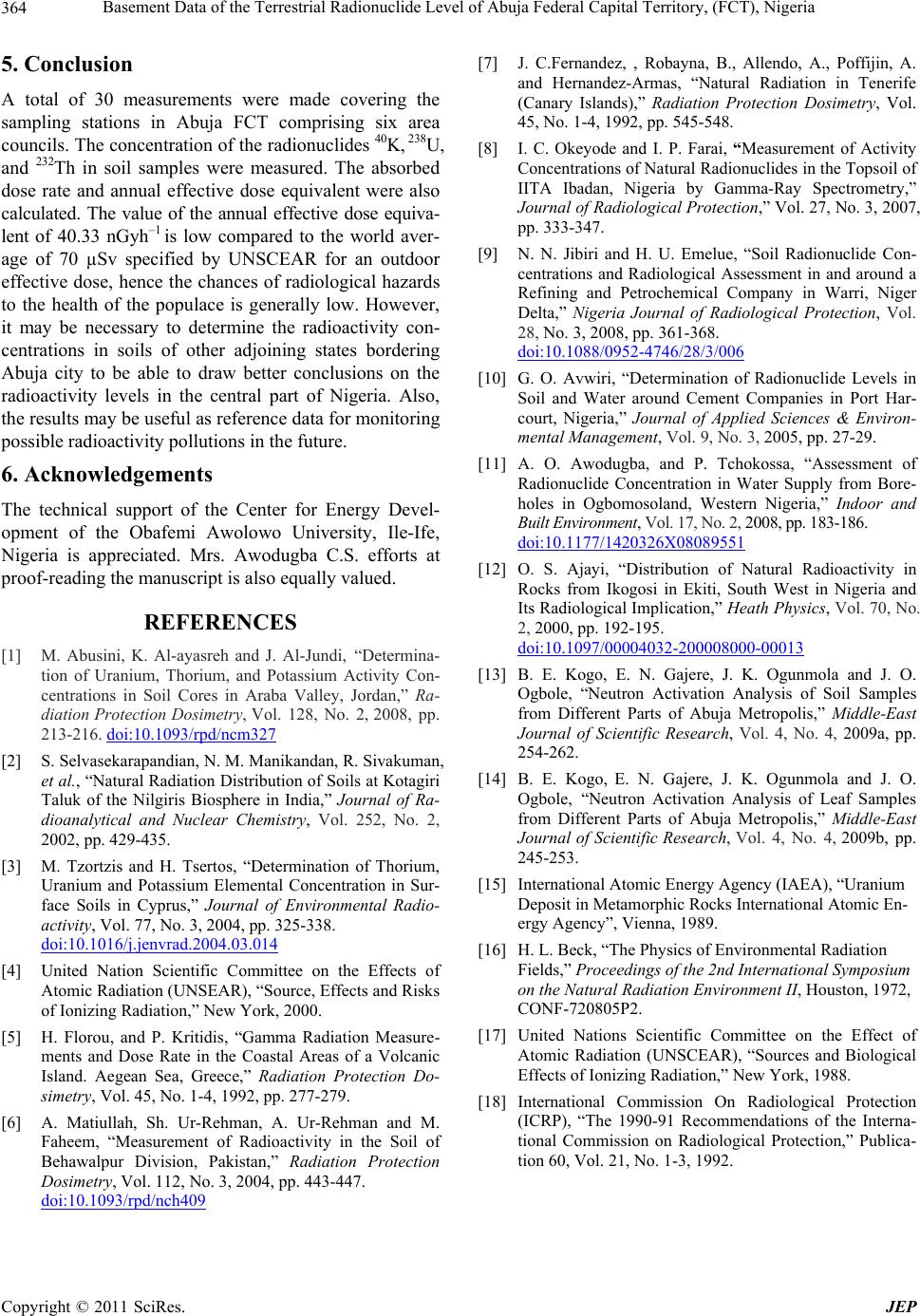
Basement Data of the Terrestrial Radionuclide Level of Abuja Federal Capital Territory, (FCT), Nigeria
364
5. Conclusion
A total of 30 measurements were made covering the
sampling stations in Abuja FCT comprising six area
councils. The concentration of the radionuclides 40K, 238U,
and 232Th in soil samples were measured. The absorbed
dose rate and annual effective dose equivalent were also
calculated. The value of the annual effective dose equiva-
lent of 40.33 nGyh–1 is low compared to the world aver-
age of 70 µSv specified by UNSCEAR for an outdoor
effective dose, hence the chances of radiological hazards
to the health of the populace is generally low. However,
it may be necessary to determine the radioactivity con-
centrations in soils of other adjoining states bordering
Abuja city to be able to draw better conclusions on the
radioactivity levels in the central part of Nigeria. Also,
the results may be useful as reference data for monitoring
possible radioactivity pollutions in the future.
6. Acknowledgements
The technical support of the Center for Energy Devel-
opment of the Obafemi Awolowo University, Ile-Ife,
Nigeria is appreciated. Mrs. Awodugba C.S. efforts at
proof-reading the manuscript is also equally valued.
REFERENCES
[1] M. Abusini, K. Al-ayasreh and J. Al-Jundi, “Determina-
tion of Uranium, Thorium, and Potassium Activity Con-
centrations in Soil Cores in Araba Valley, Jordan,” Ra-
diation Protection Dosimetry, Vol. 128, No. 2, 2008, pp.
213-216. doi:10.1093/rpd/ncm327
[2] S. Selvasekarapandian, N. M. Manikandan, R. Sivakuman,
et al., “Natural Radiation Distribution of Soils at Kotagiri
Taluk of the Nilgiris Biosphere in India,” Journal of Ra-
dioanalytical and Nuclear Chemistry, Vol. 252, No. 2,
2002, pp. 429-435.
[3] M. Tzortzis and H. Tsertos, “Determination of Thorium,
Uranium and Potassium Elemental Concentration in Sur-
face Soils in Cyprus,” Journal of Environmental Radio-
activity, Vol. 77, No. 3, 2004, pp. 325-338.
doi:10.1016/j.jenvrad.2004.03.014
[4] United Nation Scientific Committee on the Effects of
Atomic Radiation (UNSEAR), “Source, Effects and Risks
of Ionizing Radiation,” New York, 2000.
[5] H. Florou, and P. Kritidis, “Gamma Radiation Measure-
ments and Dose Rate in the Coastal Areas of a Volcanic
Island. Aegean Sea, Greece,” Radiation Protection Do-
simetry, Vol. 45, No. 1-4, 1992, pp. 277-279.
[6] A. Matiullah, Sh. Ur-Rehman, A. Ur-Rehman and M.
Faheem, “Measurement of Radioactivity in the Soil of
Behawalpur Division, Pakistan,” Radiation Protection
Dosimetry, Vol. 112, No. 3, 2004, pp. 443-447.
doi:10.1093/rpd/nch409
[7] J. C.Fernandez, , Robayna, B., Allendo, A., Poffijin, A.
and Hernandez-Armas, “Natural Radiation in Tenerife
(Canary Islands),” Radiation Protection Dosimetry, Vol.
45, No. 1-4, 1992, pp. 545-548.
[8] I. C. Okeyode and I. P. Farai, “Measurement of Activity
Concentrations of Natural Radionuclides in the Topsoil of
IITA Ibadan, Nigeria by Gamma-Ray Spectrometry,”
Journal of Radiological Protection,” Vol. 27, No. 3, 2007,
pp. 333-347.
[9] N. N. Jibiri and H. U. Emelue, “Soil Radionuclide Con-
centrations and Radiological Assessment in and around a
Refining and Petrochemical Company in Warri, Niger
Delta,” Nigeria Journal of Radiological Protection, Vol.
28, No. 3, 2008, pp. 361-368.
doi:10.1088/0952-4746/28/3/006
[10] G. O. Avwiri, “Determination of Radionuclide Levels in
Soil and Water around Cement Companies in Port Har-
court, Nigeria,” Journal of Applied Sciences & Environ-
mental Management, Vol. 9, No. 3, 2005, pp. 27-29.
[11] A. O. Awodugba, and P. Tchokossa, “Assessment of
Radionuclide Concentration in Water Supply from Bore-
holes in Ogbomosoland, Western Nigeria,” Indoor and
Built En vironm ent, Vol. 17, No. 2, 2008, pp. 183-186.
doi:10.1177/1420326X08089551
[12] O. S. Ajayi, “Distribution of Natural Radioactivity in
Rocks from Ikogosi in Ekiti, South West in Nigeria and
Its Radiological Implication,” Heath Physics, Vol. 70, No.
2, 2000, pp. 192-195.
doi:10.1097/00004032-200008000-00013
[13] B. E. Kogo, E. N. Gajere, J. K. Ogunmola and J. O.
Ogbole, “Neutron Activation Analysis of Soil Samples
from Different Parts of Abuja Metropolis,” Middle-East
Journal of Scientific Research, Vol. 4, No. 4, 2009a, pp.
254-262.
[14] B. E. Kogo, E. N. Gajere, J. K. Ogunmola and J. O.
Ogbole, “Neutron Activation Analysis of Leaf Samples
from Different Parts of Abuja Metropolis,” Middle-East
Journal of Scientific Research, Vol. 4, No. 4, 2009b, pp.
245-253.
[15] International Atomic Energy Agency (IAEA), “Uranium
Deposit in Metamorphic Rocks International Atomic En-
ergy Agency”, Vienna, 1989.
[16] H. L. Beck, “The Physics of Environmental Radiation
Fields,” Proceedings of the 2nd International Symposium
on the Natural Radiation Environment II, Houston, 1972,
CONF-720805P2.
[17] United Nations Scientific Committee on the Effect of
Atomic Radiation (UNSCEAR), “Sources and Biological
Effects of Ionizing Radiation,” New York, 1988.
[18] International Commission On Radiological Protection
(ICRP), “The 1990-91 Recommendations of the Interna-
tional Commission on Radiological Protection,” Publica-
tion 60, Vol. 21, No. 1-3, 1992.
Copyright © 2011 SciRes. JEP